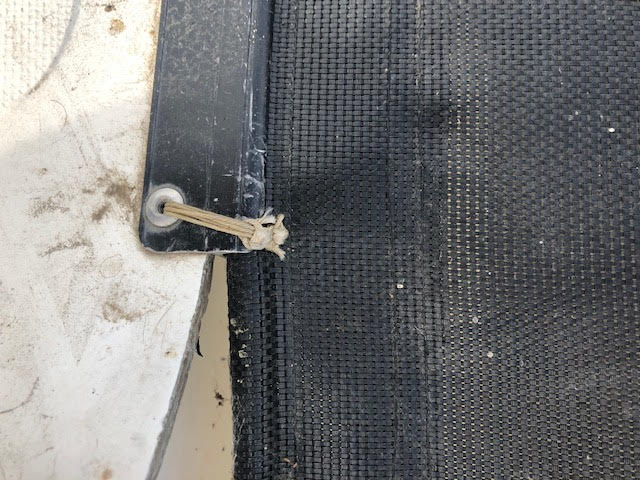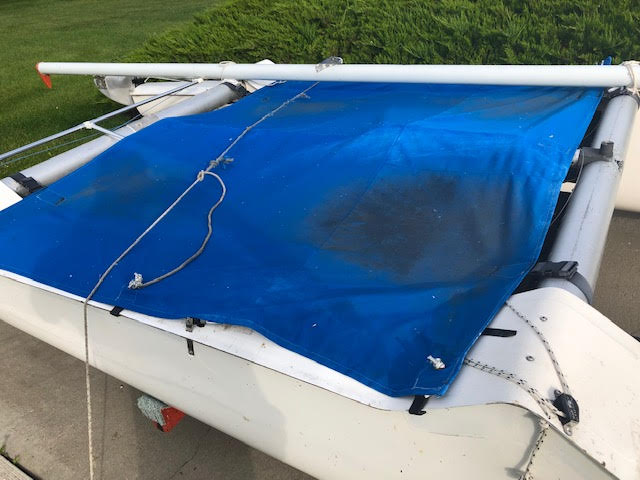2019 Nationals
REGATTA RESULTS
Click here for full results of Prairie Wind Regatta
The 2019 SeaSpray Nationals held at Lake Newell and hosted by the Newell Sailing Club went smoothly enough with fairly consistent light winds that enabled seven races. It was a large regatta with light winds and close to 80 boats across several classes.
[caption id="attachment_885" align="alignnone" width="4032"]
 L to R, Richard Braul 3rd, Hamish Ferguson 2nd and Don Snell 1st.[/caption]
L to R, Richard Braul 3rd, Hamish Ferguson 2nd and Don Snell 1st.[/caption]A fleet of 10 SeaSprays competed with the exception that one of the SeaSprays was really a Sol Cat. Seven were from NSC, one from St. Mary's Sailing Club and one from Calgary. In the photo from left to right, Richard Braul 3rd, Hamish Ferguson 2nd and Don Snell 1st. The race results are posted in the attachment.
TRAMP WOES
On another topic, we found during this event that some of the competitors boats had trampoline problems, namely their tramps were pulling out from the extrusion. I took the time to take some pictures to show what your trampoline extrusions should look like.

The left extrusion is Glenmore sailboat's supplied extrusion. The space is slightly less than 1/8" and this is the correct gap spacing. Note also the rounded entrance to allow easier placement of the trampoline into the extrusion. The top extrusion is a typical awning extrusion supplied by your local tarp or tent and awning or upholstery shop. The gap on that extrusion is closer to 1/4" and is too wide. You can pinch this to a 1/8" gap with pliers or using a bench vise. You should also round the sharp corners with a file for easier placement of the trampoline. If your tramp is consistently pulling out you will have to remove it and correctly space the extrusion. If it is at the proper spacing, likely the bolt rope is too small or has deteriorated and will have to be replaced. Make sure that you or whoever replaces the bolt rope uses the correct size rope. You can try wrapping a piece of tramp material around a potential sized rope (I think 3/16") to test to see if it will fit into the extrusion before using it for the new bolt rope. I have seen rotted wood in place of the bolt rope which seems that someone thought wood doweling would work, not! Polyester rope is the best, a bit more expensive but the advantage is it doesn't shrink in length like nylon. Polypropylene will work but may deteriorate in time. If your bolt rope is consistent but a bit too small you may be able to close the 1/8" gap a bit smaller to make it hold. Make sure your extrusion is clean. Use some spray lubricant to help slide the tramp into the extrusion.

This picture shows the end of the extrusion holding the trampoline. You will note that waxed thread has been used to hold the tramp here from pulling out. This works very well. Some variations are to use wire which is acceptable but try to find some waxed thread and a heavy needle to do this work. If your extrusion gaping is at the right width and your bolt rope is consistent and you sew or wire the ends you shouldn't have problems with your tramp pulling out. You may have to use a nail to drive out the rivet remnants out of the rivet before sewing.
(Speedy Stitcher Sewing Awl - you should consider this a must for your sailing toolbox) Available online and in stores.

Covering your trampoline to protect it from sunlight and some dirt will greatly extend the life of your tramp. If you don't cover your tramp the sewing thread will go first, the hiking strap material next and finally the tramp material itself will eventually be destroyed by the sun's rays.
The Verdict on the Aluminum Dagger boards from windknife.
I used the extruded aluminum dagger boards in this race and found them to work well. There was no hum like my wooden/glass boards make. When considering all the work involved to make wood/glass/carbon fiber boards they should be a consideration if you want to upgrade your standard boards. Downside is that they do not float and the trailing edge is near knife sharp so be careful when handling. Consider some way of tying them to the boat if capsize is a possibility or just do it anyways. There was time spent to make them fit precisely in line. I used pieces of maple (oak would do) for a guide for the trailing edge. A saw cut 1/8" deep was made dead center lengthwise and these boards were varnished and placed inside the trunks before being glassed into place. The trailing edge of these boards are almost knife edge sharp and could do some real damage if grounded. These saw cuts act as a guide to keep the boards aligned. Tape around the boards when doing your bondo or epoxy putty work to make a precise fit. Care must be taken to make sure the boards align as perfectly as possible with the lengthwise center line of each hull. At around $100 each with shipping they are a bargain and could/should be part of your boat upgrade solutions.
[caption id="attachment_872" align="alignnone" width="480"]
 Shows loops for pulling out and epoxy filled end[/caption]
Shows loops for pulling out and epoxy filled end[/caption]LIGHT WND SKILLS
Hamish mentioned that during some of the really light upwind wind sailing, flattening the mainsail was better than leaving it full. My observation was that sailing with a bit of jib luff flapping but with the leach streamers still streaming worked for some of the time going to windward. Most of the boats were fairly close speed wise. Wind shifts or being on the right tack or side of the course made big differences.
CANADIAN SEASPRAY MEMBERSHIP
Download a copy from our website now and send your payment to Hamish Ferguson — details on the form
CLICK HERE TO DOWNLOAD MEMBERSHIP FORM
